Coronavirus (COVID-19) Scotland's Strategic Framework update – February 2022: evidence paper
This evidence paper accompanies the Strategic Framework update and provides an overview of the key analysis and evidence underpinning the Framework, published on 22 February 2022.
7. Plausible scenarios
7.1 The four worlds
What may happen in the future around SARS-CoV-2 is uncertain and therefore there are a number of possible COVID-19 futures that may occur in the future. For example, the current Omicron wave may dissipate leaving low levels of COVID-19, or a new variant may emerge potentially having vaccine escape or increased severity, or people’s behaviours may change. One approach to this uncertainty is to model alternative versions of the future through the development of different COVID-19 scenarios.
Given what we know about COVID-19 these possible futures range from a world where immunity reduces COVID-19 hospitalisations and deaths to low levels, through to variant world where a variant with immune escape enters Scotland and COVID-19 hospitalisations and deaths could increase. In between these two extremes could be possible futures where vaccine effectiveness wanes or where people’s behaviour becomes polarised between those who continue with COVID-19 precautions e.g. hand washing etc. and those who don’t (see Figure 31).
The scenarios we provide in the next section look at what could happen for planning purposes, not to forecast what will happen. These scenarios include no changes from the current baseline measures. The assumptions are based on our most up to date knowledge, but do not include the effect of future changes in treatment of COVID-19 e.g. widespread use of antivirals or changes in behaviour in response to high levels of infections e.g. in variant world. Therefore, in the most extreme scenarios the peak may be lower than suggested if behaviour or restrictions changed.
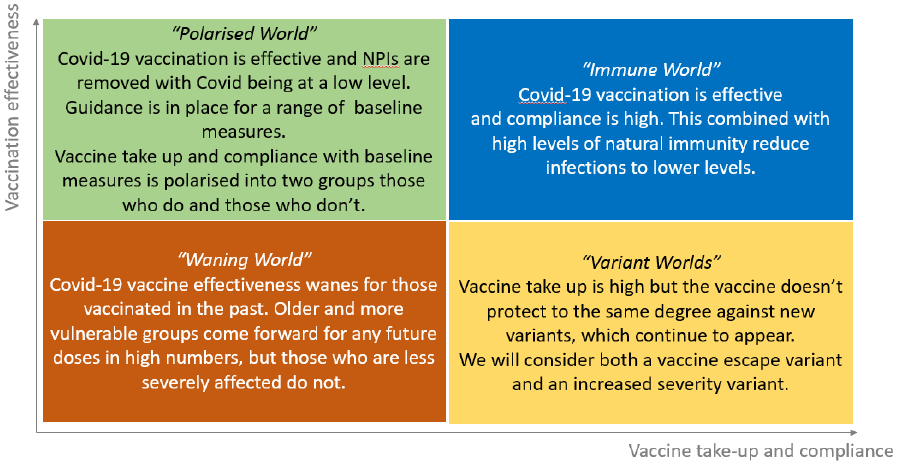
There is no linear progression between the worlds and all are plausible. Each world inherently contains a different threat level requiring a different approach to management.
7.1.1 Immune World
In this possible future vaccines and natural immunity are effective at keeping COVID-19 at low levels. Baseline measures and LFD testing are in place to protect the vulnerable e.g. elderly and immune compromised and adhered to by the public to high levels. New variants may emerge in Scotland but for the foreseeable future infections are based around Omicron.
Infections may decrease from current levels over the coming weeks and months to very low levels. Likewise hospital and ICU occupancy may follow this trend relieving the pressure on healthcare services. Issues with vaccine waning and new variants are not considered in this world and therefore levels of infections remain low (<1,000 per day) (see Figure 32).
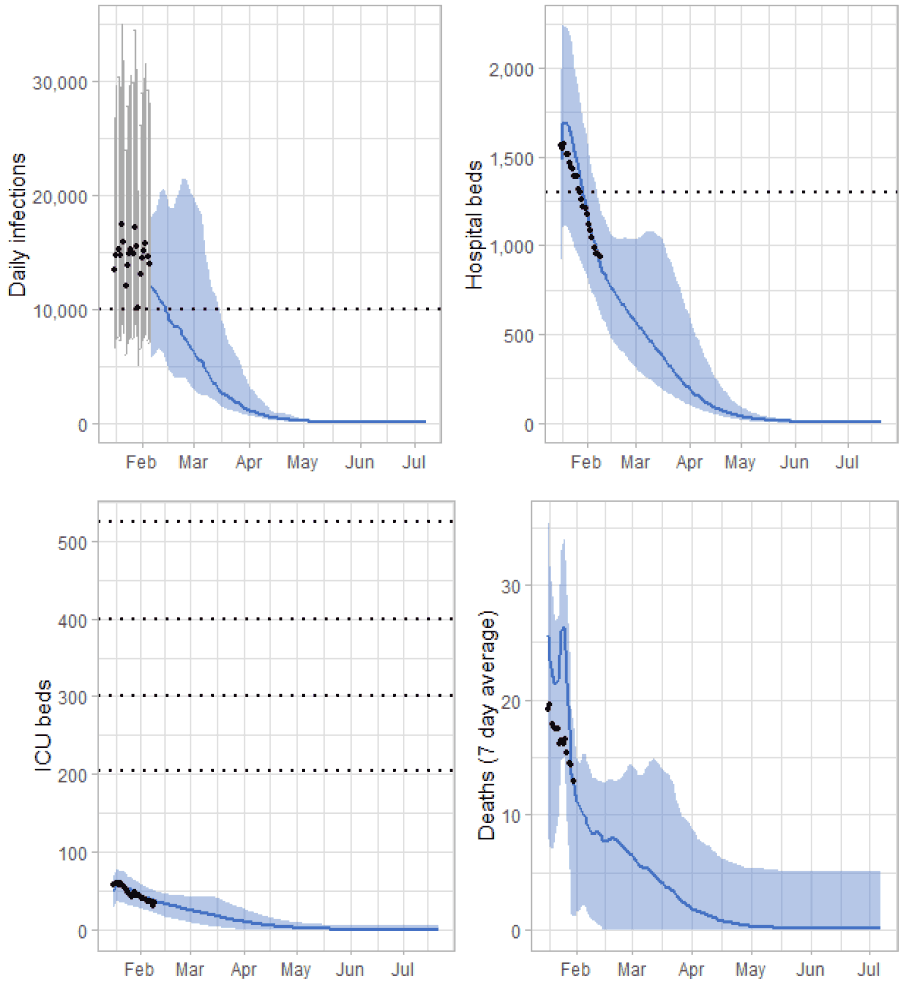
In Immune world COVID-19 in Scotland reduces below epidemic levels, becoming endemic. Cases of COVID-19 therefore spring up only as rare outbreaks which are controlled through public health measures. People’s lives return to something close to normality e.g. physical distancing is not needed but people still choose to self-isolate and hygiene is good. As vaccines are effective, take-up of first/second/third doses are good and boosters become part of an annual cycle like flu. The numbers of people who need medical treatment or hospitalisation for COVID-19 remain low.
The focus moves away from COVID-19 response and into recovery. This includes addressing learning losses, treating Long Covid and working through the hospital backlog. Wellbeing measures improve with reduced anxiety and increased happiness. Those from the highest risk groups feel they can reintegrate without government interventions. The economy begins to recover from the effects of COVID-19. Travellers do not face significant issues with trips overseas.
7.1.2 Waning world
In this world COVID-19 vaccines are effective over several months, but waning then occurs. It is hard to keep pace with booster vaccinations which become increasingly difficult to justify. Demands for vaccines throughout the rest of the world and the increasing reluctance of people in Scotland to keep being boosted reduces the overall immunity levels of the population.
Infections may not substantially decrease from current levels initially before falling in March as the natural immunity begins to offset the waning of vaccine acquired immunity.
Impacts on hospital/ICU occupancy and deaths are uncertain. While at relatively low levels infections may be between 500 – 2,000 per day by summer. These levels would be higher than has been observed in summer 2020 and 2021 and higher than what may happen in immune world (see Figure 33).
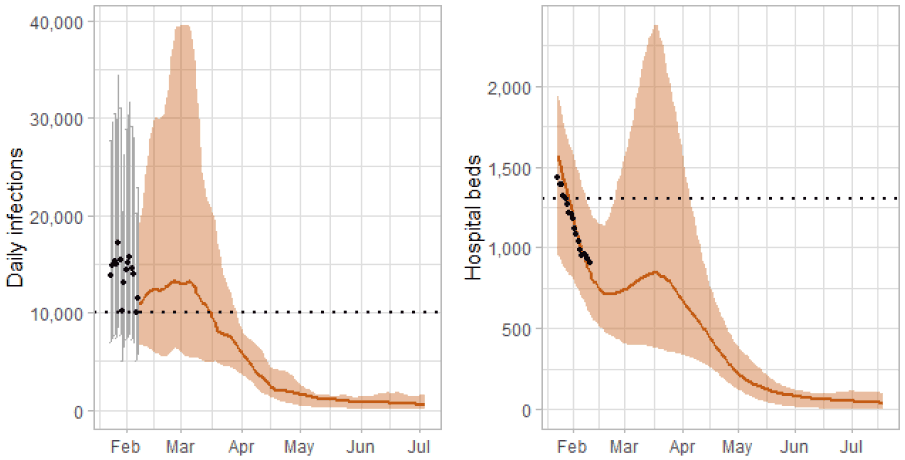
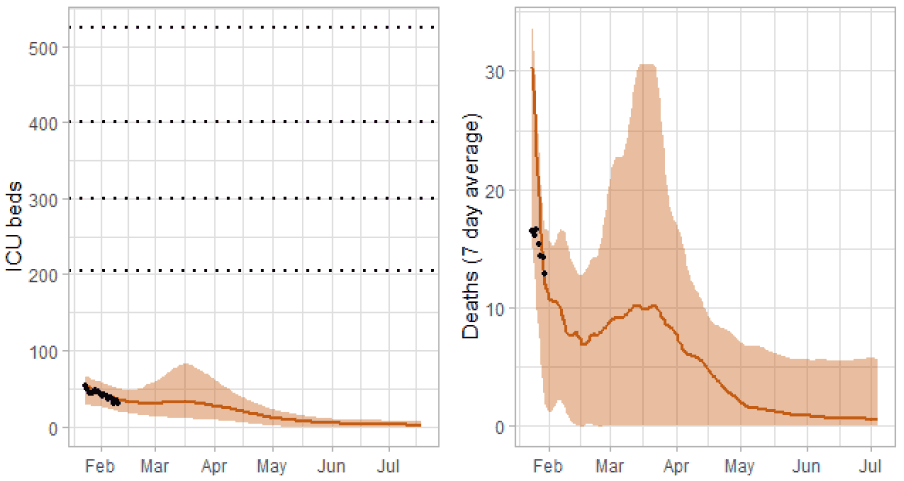
The number of people who need medical treatment or hospitalisation for COVID-19 rises particularly in vulnerable/older age groups where it is increasingly difficult to deliver an effective booster regime.
The focus continues to be on COVID-19 response and it is harder to shift on to recovery. Hospitals are still dealing with increasing cases of COVID-19 putting pressure on healthcare services and workforce which also puts pressure on other public services and budgets. Work is ongoing on rectifying learning loss but continued cases of COVID-19 within education settings with children and staff being off school slows the effectiveness of this work.
The population becomes segmented as the most vulnerable due to vaccine waning lead restricted lives or accept significant risk of serious illness and experience high levels of anxiety and low levels of wellbeing. The rest of the population live a more normal life accepting the possibility of infection with mild illness. Anxiety reduces but does not disappear, likewise wellbeing increases but there is still concern about infection. The economy continues to be impacted by workforce absences, the self-shielding actions of a proportion of the population and risk adverse behaviours.
7.1.3 Polarised world
In this world, vaccines and natural immunity are effective at reducing infections. Baseline guidance remains in place, with face coverings, physical distancing and some testing. The approach followed relies on individual risk assessment and behaviours. However society becomes polarised as some continue to take up vaccines and follow guidance while others are more reluctant. COVID-19 becomes a disease associated with those who don’t or can’t get full vaccine benefit and can’t or don’t adopt a risk based approach maintaining baseline measures.
Infections may decrease from current levels over the coming weeks and months to low levels but more slowly than in other scenarios due to various groups behaving differently across society.
This world assumes that infections continue to decrease in the coming weeks with behavioural changes beginning to occur in response to this and to the better weather from March. Unvaccinated adults and those with 1 dose are assumed to return to pre-pandemic behaviours within 6 weeks. Adults with 2 doses are assumed to return to these behaviours over 12 weeks, with those with 3 doses assumed to have no significant changes in behaviour.
Vaccine waning is included in this world whereby only some of those with 3 doses come forward for a potential 4th dose.
While at relatively low levels infections may be between 1,000 – 5,000 per day by summer. These levels would be higher than has been observed in summer 2020 and 2021 and higher than what may happen in immune world (see Figure 34).
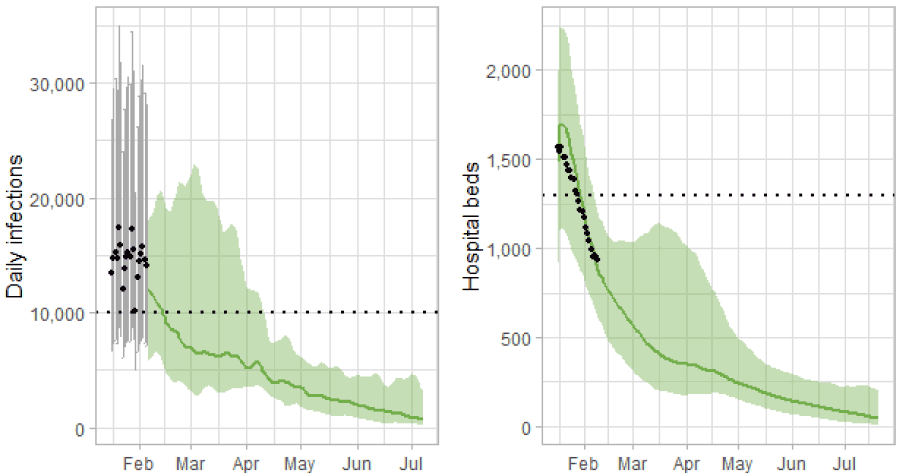
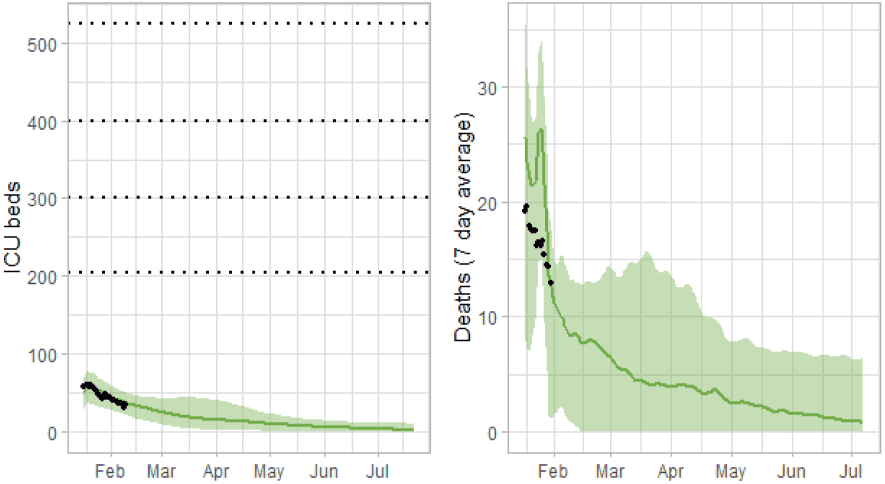
Cases of COVID-19 spring up and are hard to control in those who are not vaccinated or vulnerable. People’s lives return to a “new normal” but, due to polarised groups in society with some following and some not following the guidance on baseline restrictions, infections remain.
Vaccines are effective so older and more vulnerable people come forward for future doses in high numbers but those who are less severely affected do not. Vulnerable groups such as the very elderly and immune compromised are at risk from infection from those not vaccinated or boosted.
The focus remains on COVID-19 and it the shift onto recovery is slower. Existing learning losses are harder to rectify and continue to accrue due to infections within education settings. The hospital backlog is difficult to address as hospitals are still dealing with COVID-19 cases. The population becomes polarised in to those whose wellbeing improves e.g. lower risk people and those whose wellbeing deteriorates e.g. higher risk or poorer people whose levels of anxiety increase as COVID-19 circulates. They continue to experience greater illness, greater poverty or disruption to their income. The economy continues to be impacted from the effects of COVID-19. Unvaccinated travellers continue to face significant uncertainty with trips.
7.1.4 Variant world – vaccine escape with same severity as Delta
In this possible future a variant with vaccine escape emerges in Scotland presenting a challenge even for fully vaccinated people. This new variant leads to increased transmission, but not to increased severity. Baseline measures – face coverings, LFD, physical distancing remain and, in this scenario other NPIs may need to be put in place for a short time. This world is similar to what has happened in Scotland with the emergence of Omicron.
Omicron may be reduced to low levels within Scotland as a new variant takes over. This causes a new wave of COVID-19 infections. However this wave is not accompanied by significant numbers with serious illness and vaccines continue to protect. People’s lives are disrupted due to the increasingly high levels of infections leading to time off work ill or isolating.
To show the potential impact assume a new variant appears in Scotland as people return from their summer holidays and return to work and school. The timing is uncertain and a potential new variant may appear sooner than the summer or significantly later but has currently been lined up with the summer holidays to show illustratively what could happen. The new variant may cause Omicron infections to decrease significantly or disappear entirely (Immune world has been used to illustrate this). The new variant is modelled with similar transmissibility and vaccine escape as Omicron with severity characteristics similar to Delta. It could lead to high levels of infections leading to hospital occupancy rising above capacity restrictions. With sustained high levels of infection we could again see increased staff absences in a number of sectors that were affected by this in the recent Omicron wave.
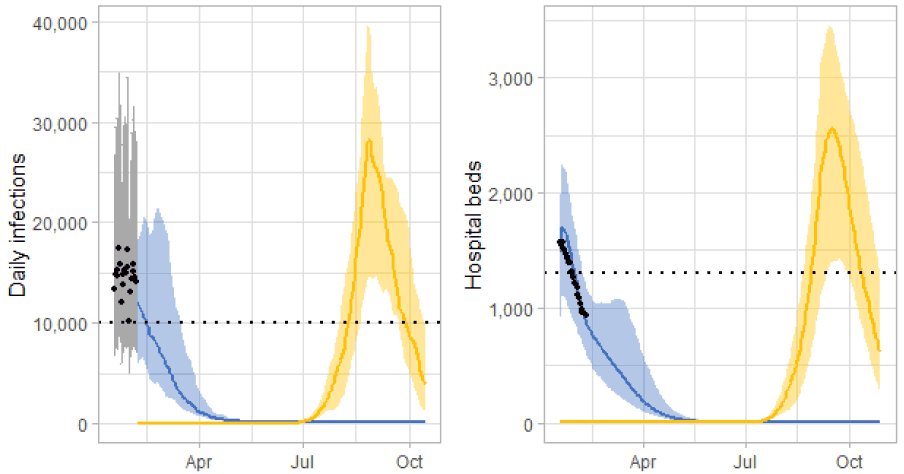
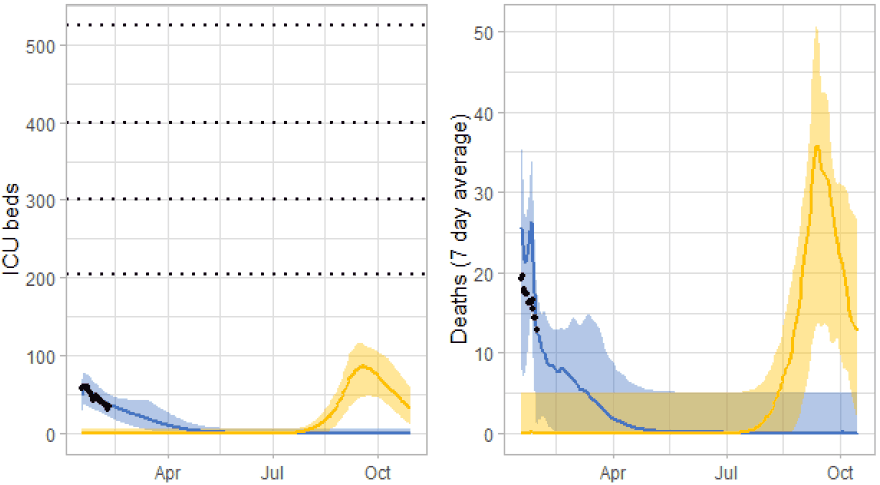
The focus remains on COVID-19 and it is hard to shift on to recovery. Continued infections within education settings and staff shortages make some school closures necessary. The COVID-19 strain on hospitals is high due to the very high numbers of infections and workforce pressures grow making it difficult to address the hospital backlog. Wellbeing measures deteriorate with people reporting low happiness and general ‘tiredness with it all’. The economy continues to be impacted from the effects of COVID-19 with many people off work. Travellers may not want to come to the UK as the new variant sweeps through.
7.1.5 Variant world – vaccine escape with increased severity compared to Delta
As with the other example of Variant world, a new variant appears in Scotland as people return from their summer holidays and return to work and school. The timing is uncertain but has currently been lined up with the summer holidays where reduced travel restrictions may make it more likely that a new variant is brought into Scotland.
The new variant may cause Omicron infections to decrease significantly or disappear entirely. It is modelled with similar transmissibility and vaccine escape as Omicron with severity characteristics 50% higher than Delta, purely for illustrative purposes.
It could lead to high levels of infections leading to hospital occupancy rising well above capacity restrictions. With sustained high levels of infection we could again see increased staff absences in a number of sectors that were affected by this in the recent Omicron wave.
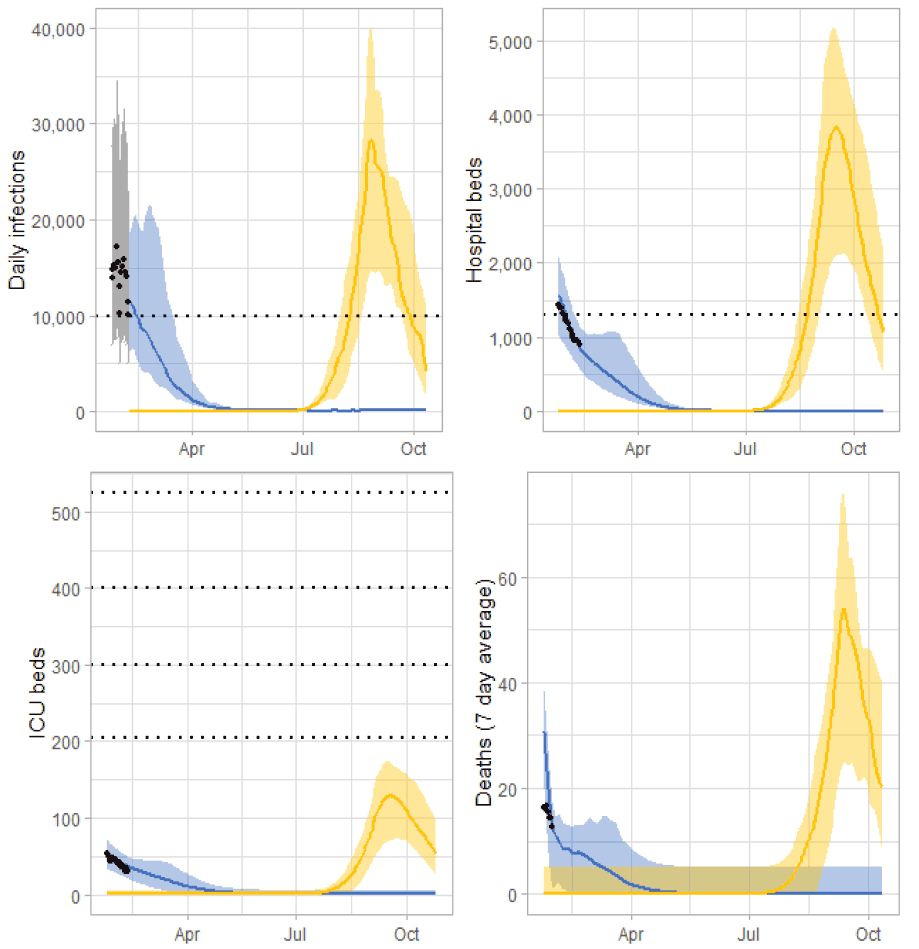
7.1.6 Background levels of COVID-19
In each of these possible futures there will be a background level of COVID-19 to plan for and manage. When comparing the worlds, Figure 37 shows the period May to September and what the background levels may look like. This ranges from under 1,000 COVID-19 infections in Scotland per day to over 5,000 in May, potentially dropping to below 2,500 in August (see Figure 37). If a new variant appeared it could be substantially higher. Depending on this background level of COVID-19 different levels of pressure will be put on the public sector in Scotland as different numbers of people become sick and need medical treatment.
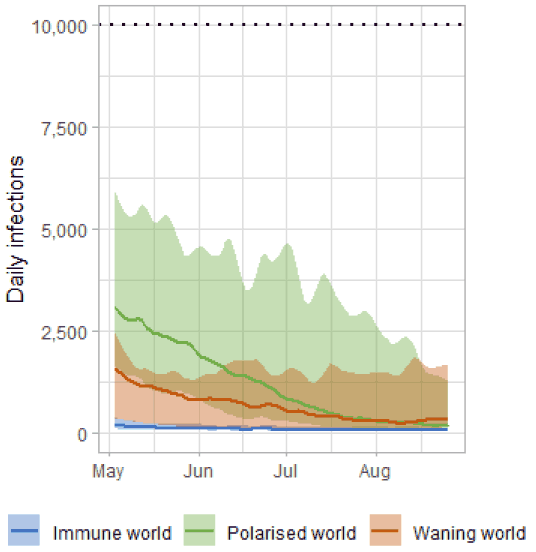
7.2 Summary
The four worlds plausible scenarios as presented in this section should not be considered predictions. It is difficult to ascertain which of these scenarios may be the more likely and in reality the situation is likely to move from one to the other and not in a linear fashion. Instead they provide some illustration of what each world could look like and the issues to be considered. Over the coming months they will be updated as circumstances change to support ongoing planning and management of the pandemic.
Contact
There is a problem
Thanks for your feedback